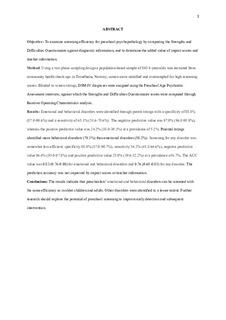| dc.description.abstract | Objective: To examine screening efficiency for preschool psychopathology by comparing the Strengths and Difficulties Questionnaire findings against diagnostic information, and to determine the added value of impact scores and teacher information. Method: Using a 2-phase sampling design, a population-based sample of 845 children 4 years of age was recruited from community health check-ups in Trondheim, Norway, screen score stratified and oversampled for high screening scores. Blinded to screen ratings, DSM-IV diagnoses were assigned using the Preschool Age Psychiatric Assessment interview, against which the Strengths and Difficulties Questionnaire scores were compared through receiver operating characteristic analysis. Results: Emotional and behavioral disorders were identified through parent ratings with a specificity of 88.8% (range, 87.0%–90.6%) and a sensitivity of 65.1% (range, 51.6–78.6%). The negative predictive value was 97.9% (range, 96.8%–98.9%), whereas the positive predictive value was 24.2% (range, 18.0%–30.3%) at a prevalence of 5.2%. Parental ratings identified more behavioral disorders (79.3%) than emotional disorders (59.2%). Screening for any disorder was somewhat less efficient: specificity, 88.9% (range, 87.0%–90.7%); sensitivity, 54.2% (range, 41.8%–66.6%); negative predictive value, 96.4% (range, 95.0%–97.8%); and positive predictive value, 25.9% (range, 19.6%–32.2%) at a prevalence of 6.7%. The area under the curve (AUC) value was 0.83 (range, 0.76–0.90) for emotional and behavioral disorders and 0.76 (range, 0.68–0.83) for any disorder. The prediction accuracy was not improved by impact scores or teacher information. Conclusions: The results indicate that preschoolers' emotional and behavioral disorders can be screened with the same efficiency as those of older children and adults. Other disorders were identified to a lesser extent. Further research should explore the potential of preschool screening to improve early detection and subsequent intervention. | |
